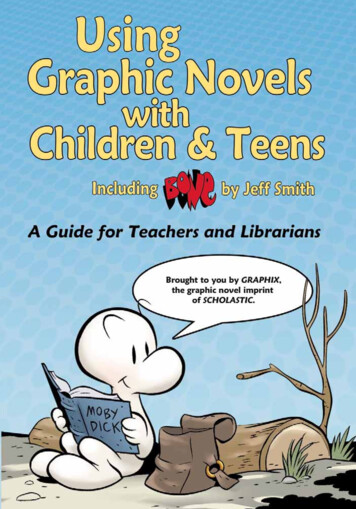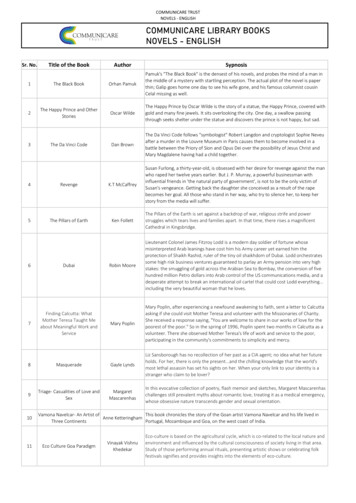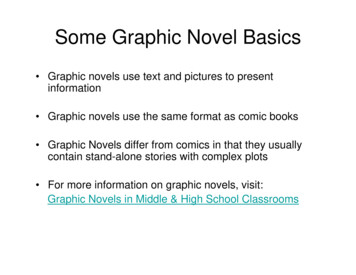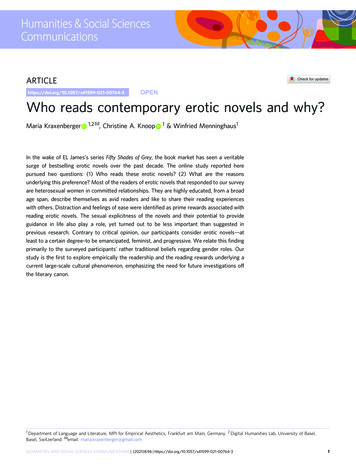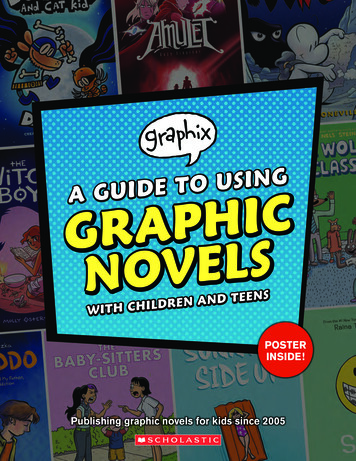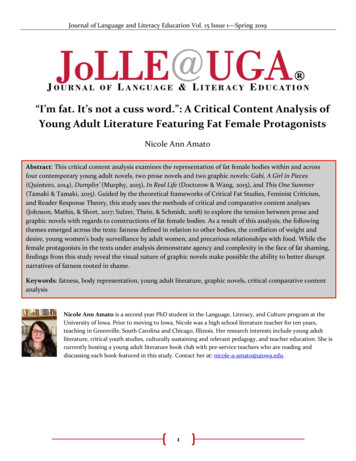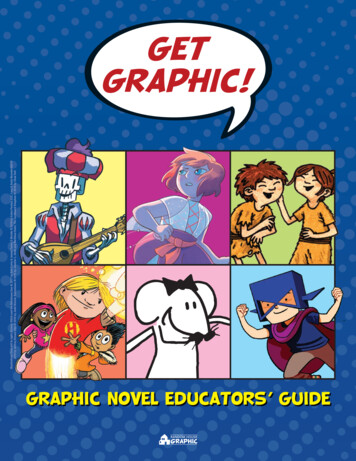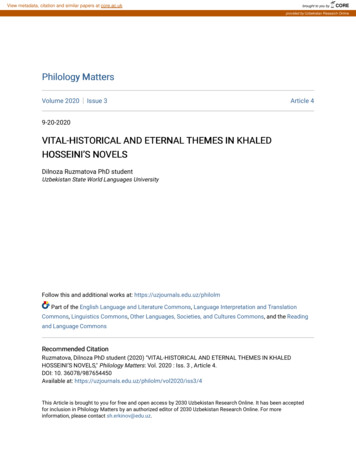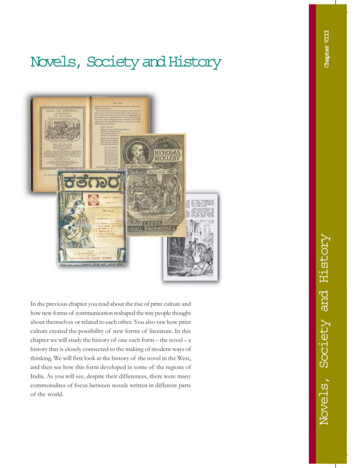
Transcription
Chapter VIIINovels,Societyand HistoryNovels, Societyand HistoryNovels, Society and HistoryIn the previous chapter you read about the rise of print culture andhow new forms of communication reshaped the way people thoughtabout themselves or related to each other. You also saw how printculture created the possibility of new forms of literature. In thischapter we will study the history of one such form – the novel – ahistory that is closely connected to the making of modern ways ofthinking. We will first look at the history of the novel in the West,and then see how this form developed in some of the regions ofIndia. As you will see, despite their differences, there were manycommonalites of focus between novels written in different partsof the world.177
1 The Rise of the NovelThe novel is a modern form of literature. It is born from print, amechanical invention.We cannot think of the novel without the printed book. In ancienttimes, as you have seen (Chapter 7), manuscripts were handwritten.These circulated among very few people. In contrast, because ofbeing printed, novels were widely read and became popular veryquickly. At this time big cities like London were growing rapidlyand becoming connected to small towns and rural areas throughprint and improved communications. Novels produced a numberof common interests among their scattered and varied readers. Asreaders were drawn into the story and identified with the lives offictitious characters, they could think about issues such as therelationship between love and marriage, the proper conduct formen and women, and so on.India and the Contemporary WorldThe novel first took firm root in England and France. Novels beganto be written from the seventeenth century, but they really floweredfrom the eighteenth century. New groups of lower-middle-classpeople such as shopkeepers and clerks, along with the traditionalaristocratic and gentlemanly classes in England and France nowformed the new readership for novels.As readership grew and the market for books expanded, the earningsof authors increased. This freed them from financial dependenceon the patronage of aristocrats, and gave them independence toexperiment with different literary styles. Henry Fielding, a novelistof the early eighteenth century, claimed he was ‘the founder of anew province of writing’ where he could make his own laws. Thenovel allowed flexibility in the form of writing. Walter Scottremembered and collected popular Scottish ballads which he usedin his historical novels about the wars between Scottish clans. Theepistolary novel, on the other hand, used the private and personalform of letters to tell its story. Samuel Richardson’s Pamela, writtenin the eighteenth century, told much of its story through an exchangeof letters between two lovers. These letters tell the reader of thehidden conflicts in the heroine’s mind.1.1 The Publishing MarketFor a long time the publishing market excluded the poor. Initially,novels did not come cheap. Henry Fielding’s Tom Jones (1749) was178New wordsGentlemanly classes – People who claimednoble birth and high social position. They weresupposed to set the standard for properbehaviourEpistolary – Written in the form of a series ofletters
issued in six volumes priced at three shillings each – which wasmore than what a labourer earned in a week.But soon, people had easier access to books with the introductionof circulating libraries in 1740. Technological improvements inprinting brought down the price of books and innovations inmarketing led to expanded sales. In France, publishers found thatthey could make super profits by hiring out novels by the hour. Thenovel was one of the first mass-produced items to be sold. Therewere several reasons for its popularity. The worlds created by novelswere absorbing and believable, and seemingly real. While readingnovels, the reader was transported to another person’s world, andbegan looking at life as it was experienced by the characters of thenovel. Besides, novels allowed individuals the pleasure of reading inprivate, as well as the joy of publicly reading or discussing storieswith friends or relatives. In rural areas people would collect to hearone of them reading a novel aloud, often becoming deeply involvedin the lives of the characters. Apparently, a group at Slough in Englandwere very pleased to hear that Pamela, the heroine of Richardson’spopular novel, had got married in their village. They rushed out tothe parish church and began to ring the church bells!New wordsSerialised – A format in which the story ispublished in instalments, each part in a newissue of a journalNovels, Society and HistoryIn 1836 a notable event took place when Charles Dickens’s PickwickPapers was serialised in a magazine. Magazines were attractive sincethey were illustrated and cheap. Serialisation allowed readers to relishthe suspense, discuss the characters of a novel and live for weekswith their stories – like viewers of television soaps today!Fig. 1 – Cover page of Sketches by ‘Boz’.Charles Dickens’s first publication was a collection ofjournalistic essays entitled Sketches by ‘Boz’ (1836).Fig. 2 – Library notice.Libraries were well publicised.Fig. 3 – Cover page of All The Year Round.The most important feature of the magazineAll the Year Round, edited by CharlesDickens, was his serialised novels. Thisparticular issue begins with one.179
Fig. 4 – Leo Tolstoy (1828-1910).Tolstoy was a famous Russian novelist who wrote extensively onrural life and community.1.2 The World of the NovelIndia and the Contemporary WorldMore than other forms of writing which came before, novels areabout ordinary people. They do not focus on the lives of greatpeople or actions that change the destinies of states and empires.Instead, they are about the everyday life of common people.In the nineteenth century, Europe entered the industrial age.Factories came up, business profits increased and the economy grew.But at the same time, workers faced problems. Cities expandedin an unregulated way and were filled with overworked andunderpaid workers. The unemployed poor roamed the streets forjobs, and the homeless were forced to seek shelter in workhouses.The growth of industry was accompanied by an economicphilosophy which celebrated the pursuit of profit and undervaluedthe lives of workers. Deeply critical of these developments, novelistssuch as Charles Dickens wrote about the terrible effects ofindustrialisation on people’s lives and characters. His novel Hard Times(1854) describes Coketown, a fictitious industrial town, as a grimplace full of machinery, smoking chimneys, rivers polluted purpleand buildings that all looked the same. Here workers are knownas ‘hands’, as if they had no identity other than as operatorsof machines. Dickens criticised not just the greed for profits butalso the ideas that reduced human beings into simple instrumentsof production.180DiscussExplain what is meant by the following types ofnovels:¾ Epistolary novel¾ Serialised novelFor each type, name one writer who wrote inthat style.Fig. 5 – Charles Dickens(1812-1870).
In other novels too, Dickens focused on the terrible conditions ofurban life under industrial capitalism. His Oliver Twist (1838) is thetale of a poor orphan who lived in a world of petty criminals andbeggars. Brought up in a cruel workhouse (see Fig. 6), Oliver wasfinally adopted by a wealthy man and lived happily ever after.But not all novels about the lives of the poor gave readers the comfortof a happy ending. Emile Zola’s Germinal (1885) onthe life of a young miner in France explores in harsh detail thegrim conditions of miners’ lives. It ends on a note of despair: thestrike the hero leads fails, his co-workers turn against him, andhopes are shattered.Novels, Society and HistoryFig. 6 – A hungry Oliver asks for morefood while other children at the workhouselook on with fearfear,, illustration in OliverTwist.Fig. 7 – Emile Zola, painting by Edward Manet,1868.Manet’s portrait of the French author Zola,showing the novelist at his worktable in anintimate and thoughtful relationship with books.1.3 Community and SocietyThe vast majority of readers of the novel lived in the city. The novelcreated in them a feeling of connection with the fate of ruralcommunities. The nineteenth-century British novelist Thomas Hardy,for instance, wrote about traditional rural communities of England181
that were fast vanishing. This was actually a time when large farmersfenced off land, bought machines and employed labourers toproduce for the market. The old rural culture with its independentfarmers was dying out. We get a sense of this change in Hardy’sMayor of Casterbridge (1886). It is about Michael Henchard, a successfulgrain merchant, who becomes the mayor of the farming town ofCasterbridge. He is an independent-minded man who follows hisown style in conducting business. He can also be both unpredictablygenerous and cruel with his employees. Consequently, he is nomatch for his manager and rival Donald Farfrae who runs hisbusiness on efficient managerial lines and is well regarded for heis smooth and even-tempered with everyone. We can see thatHardy mourns the loss of the more personalised world that isdisappearing, even as he is aware of its problems and the advantagesof the new order.The novel uses the vernacular, the language that is spoken bycommon people. By coming closer to the different spoken languagesof the people, the novel produces the sense of a shared worldbetween diverse people in a nation. Novels also draw from differentstyles of language. A novel may take a classical language and combineit with the language of the streets and make them all a part of thevernacular that it uses. Like the nation, the novel brings togethermany cultures.India and the Contemporary World1.4 The New WomanThe most exciting element of the novel was the involvement ofwomen. The eighteenth century saw the middle classes becomemore prosperous. Women got more leisure to read as well as writenovels. And novels began exploring the world of women – theiremotions and identities, their experiences and problems.Many novels were about domestic life – a theme about whichwomen were allowed to speak with authority. They drewupon their experience, wrote about family life and earnedpublic recognition.New wordsVernacular – The normal, spoken form of a language ratherthan the formal, literary form182Fig. 8 – Thomas Hardy (1840-1928).
Novels, Society and HistoryFig. 9 – A girl reading, a painting by Jean Renoir (1841-1919).By the nineteenth century, images of women reading silently, inthe privacy of the room, became common in European paintings.Fig. 1100 – The home of a woman authorauthor,, by George CruikshankCruikshank.When women began writing novels many people feared that they would nowneglect their traditional role as wives and mothers and homes would be in disorder.183
The novels of Jane Austen give us a glimpse of the world of womenin genteel rural society in early-nineteenth-century Britain. Theymake us think about a society which encouraged women to lookfor ‘good’ marriages and find wealthy or propertied husbands. Thefirst sentence of Jane Austen’s Pride and Prejudice states: ‘It is a truthuniversally acknowledged, that a single man in possession of a goodfortune, must be in want of a wife.’ This observation allows us tosee the behaviour of the main characters, who are preoccupied withmarriage and money, as typifying Austen’s society.Fig. 11 – Jane Austen(1775-1817).India and the Contemporary WorldBut women novelists did not simply popularise the domestic roleof women. Often their novels dealt with women who brokeestablished norms of society before adjusting to them. Such storiesallowed women readers to sympathise with rebellious actions. InCharlotte Bronte’s Jane Eyre, published in 1847, young Jane is shownas independent and assertive. While girls of her time were expectedto be quiet and well behaved, Jane at the age of ten protests againstthe hypocrisy of her elders with startling bluntness. She tells herFig. 12 – The marriage contract, William Hogarth (1697-1764).As you can see, the two men in the foreground are busy with the signing of the marriagecontract while the woman stays in the background.184
Aunt who is always unkind to her: ‘People think you a good woman,but you are bad . You are deceitful! I will never call you aunt aslong as I live.’Box 1Women novelistsGeorge Eliot (1819-1880) was the pen-name of Mary Ann Evans.A very popular novelist, she believed that novels gave women aspecial opportunity to express themselves freely. Every womancould see herself as capable of writing fiction:‘Fiction is a department of literature in which women can, aftertheir kind, fully equal men No educational restrictions can shutwomen from the materials of fiction, and there is no species of artthat is so free from rigid requirements.’Fig. 13 – Charlotte Bronte (1816-1855).George Eliot, ‘Silly novels by lady novelists’, 1856.1.5 Novels for the YoungG.A. Henty’s historical adventure novels for boys were also wildlypopular during the height of the British empire. They aroused theexcitement and adventure of conquering strange lands. They wereset in Mexico, Alexandria, Siberia and many other countries. Theywere always about young boys who witness grand historical events,get involved in some military action and show what they called‘English’ courage.Love stories written for adolescent girls also first became popularin this period, especially in the US, notably Ramona (1884) by HelenHunt Jackson and a series entitled What Katy Did (1872) by SarahChauncey Woolsey, who wrote under the pen-name Susan Coolidge.Box 2G.A. Henty (1832-1902):In Under Drake’s Flag (1883) two youngElizabethan adventurers face their apparentlyapproaching death, but still remember to asserttheir Englishness:‘Well, Ned, we have had more good fortune thanwe could have expected. We might have beenkilled on the day when we landed, and we havespent six jolly months in wandering together ashunters on the plain. If we must die, let usbehave like Englishmen and Christians.’185Novels, Society and HistoryNovels for young boys idealised a new type of man: someonewho was powerful, assertive, independent and daring. Most of thesenovels were full of adventure set in places remote from Europe.The colonisers appear heroic and honourable – confronting ‘native’peoples and strange surroundings, adapting to native life as well aschanging it, colonising territories and then developing nations there.Books like R.L. Stevenson’s Treasure Island (1883) or Rudyard Kipling’sJungle Book (1894) became great hits.
1.6 Colonialism and AfterThe novel originated in Europe at a time when it was colonising therest of the world. The early novel contributed to colonialism bymaking the readers feel they were part of a superior community offellow colonialists. The hero of Daniel Defoe’s Robinson Crusoe (1719)is an adventurer and slave trader. Shipwrecked on an island, Crusoetreats coloured people not as human beings equal to him, but asinferior creatures. He rescues a ‘native’ and makes him his slave. Hedoes not ask for his name but arrogantly gives him the name Friday.But at the time, Crusoe’s behaviour was not seen as unacceptable orodd, for most writers of the time saw colonialism as natural.Colonised people were seen as primitive and barbaric, less thanhuman; and colonial rule was considered necessary to civilise them,to make them fully human. It was only later, in the twentieth century,that writers like Joseph Conrad (1857-1924) wrote novels thatshowed the darker side of colonial occupation.India and the Contemporary WorldThe colonised, however, believed that the novel allowed them toexplore their own identities and problems, their own nationalconcerns. Let us see how the novel became popular in India andwhat significance it had for society.186
2 The Novel Comes to IndiaStories in prose were not new to India. Banabhatta’s Kadambari,written in Sanskrit in the seventh century, is an early example. ThePanchatantra is another. There was also a long tradition of prosetales of adventure and heroism in Persian and Urdu, known as dastan.However, these works were not novels as we know them today.The modern novel form developed in India in the nineteenth century,as Indians became familiar with the Western novel. The developmentof the vernaculars, print and a reading public helped in this process.Some of the earliest Indian novels were written in Bengali andMarathi. The earliest novel in Marathi was Baba Padmanji’s YamunaParyatan (1857), which used a simple style of storytelling to speakabout the plight of widows. This was followed by LakshmanMoreshwar Halbe’s Muktamala (1861). This was not a realistic novel;it presented an imaginary ‘romance’ narrative with a moral purpose.Leading novelists of the nineteenth century wrote for a cause.Colonial rulers regarded the contemporary culture of India as inferior.On the other hand, Indian novelists wrote to develop a modernliterature of the country that could produce a sense of nationalbelonging and cultural equality with their colonial masters.Translations of novels into different regional languages helped tospread the popularity of the novel and stimulated the growth ofthe novel in new areas.Box 3Not all Marathi novels were realistic. Naro SadashivRisbud used a highly ornamental style in his Marathinovel Manjughosha (1868). This novel was filledwith amazing events. Risbud had a reason behindhis choice of style. He said:‘Because of our attitude to marriage and forseveral other reasons one finds in the lives of theHindus neither interesting views nor virtues Ifwe write about things that we experiencedaily there would be nothing enthralling aboutthem, so that if we set out to write anentertaining book we are forced to take up withthe marvellous.’Novels began appearing in south Indian languages during the periodof colonial rule. Quite a few early novels came out of attempts totranslate English novels into Indian languages. For example,O. Chandu Menon, a subjudge from Malabar, tried to translate anEnglish novel called Henrietta Temple written by Benjamin Disraeliinto Malayalam. But he quickly realised that his readers in Keralawere not familiar with the way in which the characters in Englishnovels lived: their clothes, ways of speaking, and manners wereunknown to them. They would find a direct translation of an Englishnovel dreadfully boring. So, he gave up this idea and wrote insteada story in Malayalam in the ‘manner of English novel books’. Thisdelightful novel called Indulekha, published in 1889, was the firstmodern novel in Malayalam.Novels, Society and History2.1 The Novel in South IndiaFig. 14 – Chandu Menon(1847-1899).187
The case of Andhra Pradesh was strikingly similar. KandukuriViresalingam (1848-1919) began translating Oliver Goldsmith’s Vicarof Wakefield into Telugu. He abandoned this plan for similar reasonsand instead wrote an original Telugu novel called Rajasekhara Caritamuin 1878.Fig. 15 – Image from Pickwick Abroad.A drawing from the book Pickwick Abroad written byG.W.M. Reynolds.Minor nineteenth-century English novelists like Reynolds,F. Marion Crawford and Marie Corelli were hugely popular incolonial India. Their novels – which were historical romances,adventure stories and sensation novels – were easily availableand were translated and ‘adapted’ into several Indian languages.Reynolds’s Pickwick Abroad (1839) was more popular in Indiathan Dickens’s original Pickwick Papers (1837) .India and the Contemporary World2.2 The Novel in HindiIn the north, Bharatendu Harishchandra, the pioneer of modernHindi literature, encouraged many members of his circle of poetsand writers to recreate and translate novels from other languages.Many novels were actually translated and adapted from English andBengali under his influence, but the first proper modern novel waswritten by Srinivas Das of Delhi.Srinivas Das’s novel, published in 1882, was titled Pariksha-Guru (TheMaster Examiner). It cautioned young men of well-to-do familiesagainst the dangerous influences of bad company and consequentloose morals.Pariksha-Guru reflects the inner and outer world of the newly emergingmiddle classes. The characters in the novel are caught in the difficultyof adapting to colonised society and at the same time preserving188
their own cultural identity. The world of colonial modernity seemsto be both frightening and irresistible to the characters. The noveltries to teach the reader the ‘right way’ to live and expects all ‘sensiblemen’ to be worldly-wise and practical, to remain rooted in thevalues of their own tradition and culture, and to live with dignityand honour.In the novel we see the characters attempting to bridge two differentworlds through their actions: they take to new agricultural technology,modernise trading practices, change the use of Indian languages,making them capable of transmitting both Western sciences andIndian wisdom. The young are urged to cultivate the ‘healthy habit’of reading the newspapers. But the novel emphasises that allthis must be achieved without sacrificing the traditional values ofthe middle-class household. With all its good intentions, ParikshaGuru could not win many readers, as it was perhaps too moralisingin its style.It was with the writing of Premchand that the Hindi novel achievedexcellence. He began writing in Urdu and then shifted to Hindi,remaining an immensely influential writer in both languages. He drewon the traditional art of kissa-goi (storytelling). Many critics thinkthat his novel Sewasadan (The Abode of Service), published in 1916,lifted the Hindi novel from the realm of fantasy, moralising andsimple entertainment to a serious reflection on the lives of ordinarypeople and social issues. Sewasadan deals mainly with the poorcondition of women in society. Issues like child marriage and dowryare woven into the story of the novel. It also tells us about the waysin which the Indian upper classes used whatever little opportunitiesthey got from colonial authorities to govern themselves.2.3 Novels in BengalIn the nineteenth century, the early Bengali novels lived in two worlds.Many of these novels were located in the past, their characters, eventsDiscussWrite about two important characteristics of theearly Hindi novel.Box 4The novel in AssamThe first novels in Assam were written bymissionaries. Two of them were translations ofBengali including Phulmoni and Karuna. In 1888,Assamese students in Kolkata formed the AsamyaBhasar Unnatisadhan that brought out a journalcalled Jonaki . This journal opened up theopportunities for new authors to develop thenovel. Rajanikanta Bardoloi wrote the first majorhistorical novel in Assam called Manomati (1900).It is set in the Burmese invasion, stories of whichthe author had probably heard from old soldierswho had fought in the 1819 campaign. It is atale of two lovers belonging to two hostile familieswho are separated by the war and finallyreunited.189Novels, Society and HistoryThe writings of Devaki Nandan Khatri created a novel-readingpublic in Hindi. His best-seller, Chandrakanta – a romance withdazzling elements of fantasy – is believed to have contributedimmensely in popularising the Hindi language and the Nagariscript among the educated classes of those times. Although it wasapparently written purely for the ‘pleasure of reading’, this novelalso gives some interesting insights into the fears and desires of itsreading public.
and love stories based on historical events. Another group of novelsdepicted the inner world of domestic life in contemporary settings.Domestic novels frequently dealt with the social problems andromantic relationships between men and women.The old merchant elite of Calcutta patronised public forms ofentertainment such as kabirlarai (poetry contests), musical soireesand dance performances. In contrast, the new bhadralok foundhimself at home in the more private world of reading novels.Novels were read individually. They could also be read in selectgroups. Sometimes the household of the great Bangla novelistBankim Chandra Chattopadhyay would host a jatra in the courtyardwhere members of the family would be gathered. In Bankim’s room,however, a group of literary friends would collect to read, discussand judge literary works. Bankim read out Durgeshnandini (1865),his first novel, to such a gathering of people who were stunned torealise that the Bengali novel had achieved excellence so quickly.Besides the ingenious twists and turns of the plot and the suspense,the novel was also relished for its language. The prose style becamea new object of enjoyment. Initially the Bengali novel used a colloquialstyle associated with urban life. It also used meyeli, the languageassociated with women’s speech. This style was quickly replacedby Bankim’s prose which was Sanskritised but also contained amore vernacular style.India and the Contemporary WorldThe novel rapidly acquired popularity in Bengal. By the twentiethcentury, the power of telling stories in simple language made SaratChandra Chattopadhyay (1876-1938) the most popular novelist inBengal and probably in the rest of India.Fig. 16 – Bankim Chandra Chattopadhyay(1838-1894).Bankim’s hands on the book indicates howwriting was the basis of his social positionand authority.Box 5The Oriya novelIn 1877-78, Ramashankar Ray, a dramatist, beganserialising the first Oriya novel, Saudamani. Buthe could not complete it. Within thirty years,however, Orissa produced a major novelist in FakirMohon Senapati (1843-1918). The title of hisnovel Chaa Mana Atha Guntha (1902) translatesas six acres and thirty-two decimals of land. Itannounces a new kind of novel that will deal withthe question of land and its possession. It is thestory of Ramchandra Mangaraj, a landlord’smanager who cheats his idle and drunken masterand then eyes the plot of fertile land owned byBhagia and Shariya, a childless weaver couple.Mangaraj fools this couple and puts them into hisdebt so that he can take over their land. Thispathbreaking work showed that the novel couldmake rural issues an important part of urbanpreoccupations. In writing this novel, Fakir Mohonanticipated a host of writers in Bengal andelsewhere.Fig. 1177 – The temple and the drawing room.On the right is the temple where the family and others would gatherand on the left is the drawing room where Bankim would entertainselect friends to discuss new literary works. Note that the twospaces – the traditional and the modern – are next to each other,indicating the split lifestyle of most intellectuals in colonial India.190
3 Novels in the Colonial WorldIf we follow the history of the novel in different parts of India wecan see many regional peculiarities. But there were also recurringpatterns and common concerns. What inspired the authors to writenovels? Who read the novels? How did the culture of readingdevelop? How did the novels grapple with the problems of societalchange within a colonial society? What kind of a world did novelsopen up for the readers? Let us explore some of these questionsby focusing primarily on the writings of three authors from differentregions: Chandu Menon, Bankim Chandra Chattopadhyayand Premchand.3.1 Uses of the NovelIndians used the novel as a powerful medium to criticise what theyconsidered defects in their society and to suggest remedies. Writerslike Viresalingam used the novel mainly to propagate their ideasabout society among a wider readership.Novels also helped in establishing a relationship with the past. Manyof them told thrilling stories of adventures and intrigues set in thepast. Through glorified accounts of the past, these novels helped increating a sense of national pride among their readers.At the same time, people from all walks of life could read novels solong as they shared a common language. This helped in creating asense of collective belonging on the basis of one’s language.You would have noticed that people living in different regions speakthe same language in different ways – sometimes they use differentwords for the same thing; sometimes the same word is pronounceddifferently. With the coming of novels, such variations entered theFig. 18 – Cover page of the novelIndirabai.Written at the end of the nineteenthcentury, Indirabai continues to bepopular and is regularly reprinted. Thisis the cover of a recent reprint.Box 6The message of reformMany early novels carried a clear message ofsocial reform. For example, in Indirabai , aKannada novel written by Gulavadi Venkata Raoin 1899, the heroine is given away in marriageat a very young age to an elderly man. Herhusband dies soon after, and she is forced tolead the life of a widow. In spite of oppositionfrom her family and society, Indirabai succeedsin continuing her education. Eventually shemarries again, this time a progressive, Englisheducated man. Women’s education, the plightof widows, and problems created by the earlymarriage of girls – all these were important issuesfor social reformers in Karnataka at that time.191Novels, Society and HistoryColonial administrators found ‘vernacular’ novels a valuable sourceof information on native life and customs. Such information wasuseful for them in governing Indian society, with its large variety ofcommunities and castes. As outsiders, the British knew little aboutlife inside Indian households. The new novels in Indian languagesoften had descriptions of domestic life. They showed how peopledressed, their forms of religious worship, their beliefs and practices,and so on. Some of these books were translated into English, oftenby British administrators or Christian missionaries.
Box 7The most popular historical novelist in Tamil wasR. Krishnamurthy who wrote under the penname ‘Kalki’. He was an active participant in thefreedom movement and the editor of the widelyread Tamil maga
And novels began exploring the world of women - their emotions and identities, their experiences and problems. Many novels were about domestic life - a theme about which women were allowed to speak with authority. They drew upon their experience, wrote about family life and earned public recognition. New words Vernacular - The normal, spoken form of a language rather than the formal .

